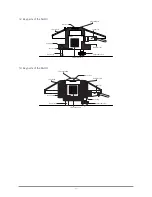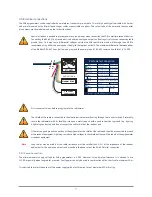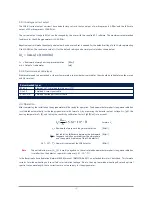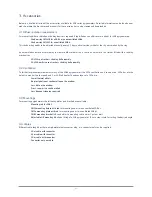
Net radiation configuration
Mounting plate
Upper screen
R
S
h
d
lower screen
always point the cables
to the nearest pole
pyrgeometer
Mast
The requirements for installation of the upper and lower pyrgeometers
are the same as in paragraphs for downward and upward long-wave
radiation. According to the WMO the pyrgeometer configuration
should be 1 to 2 meter above an uniform surface covered by short
grass.
The mast shown intercepts a fraction D/2πS of the radiation that is
coming from the ground. In the most unfavourable situation (sun at
zenith) the pyrgeometer shadow decreases the signal by a factor R²/H².
When determining the net long-wave radiation, it is not strictly necessary
to record the pyrgeometer housing temperatures. Assuming that the
temperatures of the upper and lower housings are equal, it can be
cancelled from the equation for net-radiation.
Kipp & Zonen produces a universal shadow ring, model CM121, which is suitable for use at all latitudes. In the CM121 manual,
installation instructions and correction factors are given.
In practice the SGR4 does not require shading from direct short-wave solar radiation because the window-heating effect, when
suitably ventilated, is negligible due to the unique construction of the pyrgeometer.
2.2.5 Installation for measurement of net long-wave radiation
A net pyrgeometer measures both the downward atmospheric long-wave radiation and the upward long-wave radiation from the
surface below. It can be configured from two SGR-series pyrgeometers and a suitable mounting plate. In the case of the SGR3, two
instruments can be simply mounted back-to-back and an optional mounting rod fitted.
However, if the upward and downward radiation components are to be measured separately it is necessary to record the individual
housing temperatures to calculate the radiation values.
Using the combination of a net pyrgeometer (two SGR3 or SGR4 instruments) and an albedometer (two SMP6 or SMP11) the net
total radiation (energy balance) can be calculated with high accuracy from the four component values. Problems with dew
deposition, frost, etc, can be minimised by using the Kipp & Zonen CVF4 ventilation unit with optional heating.
This has many advantages over conventional net total radiation sensors with plastic (polyethylene) windows. These cannot
provide individual short and long-wave radiation values and cannot separate upward and downward contributions. The soft
plastic windows do not fully protect the sensor from the thermal effects of wind and rain, are easily soiled, are difficult to clean
and require regular replacement.
14





























